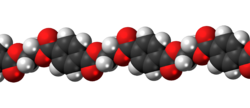The Toxins in Your Closet
One of the most common fibers in our modern day world is polyester. Most of our clothes, socks, blankets, sheets, drapes, furniture is either made from polyester or a fabric blended with polyester, specifically polyethylene terephthalate (PET, PETE), the "most common thermoplastic polymer resin". PET is a synthetic fiber that starts off as ethane, a hydrocarbon gas (What we're learning right
now!), which is a byproduct of petroleum refining. At standard temperature and pressure and in its purest form, ethane is a colorless and odorless gas.
(Ethylene)
(terephthalic acid)
When heated to a temperature of 800C (~ 1500F), ethane becomes ethylene oxide through a process called cracking. In its purest form and at standard temperature and pressure, ethylene is a colorless flammable gas with a scent described as "sweet and musky". After cracking, water is added to it, resulted in ethylene glycol [ C2H4O + H2O → HO–CH2CH2–OH ], also known as antifreeze. (Ethylene glycol a dangerous and complex chemical that can cause many complications to the body: 4 fluid ounces is enough to be fatal to an average sized man by causing metabolic acidosis, which leads to organ failure and brain, liver, lung and kidney damage). The next step is to add terephthalic acid to the ethylene glycol (combined with a heavy metal) to create PET.
(molecular structure of polyethylene terephthalate chains)
(PET chips)
After this process, a heavy metal catalyst is added to it, usually antimony, and a high viscosity liquid is formed, resembling goop. Under low vacuum pressure, these polymer chains begin to get longer and once it obtains an appropriate length, the reaction is stopped, resulting in long, noodle like strands of PET, which is then quickly cooled and cut into pellets. After becoming pellets, they can be reheated to be stretched in one direction to become a fiber (to be made into clothes) or stretched in multiple directions (for films or bottles). Quick cooling while stretched causes the polymer chains to freeze with their orientation intact, making the material very durable. PET can also be stretched at elevated temperatures continuously until it begins to crystallize, becoming opaque, rigid and inflexible. This material is often used for plastic containers and trays that are then reheated in ovens and microwaves.
We wear our clothes for most hours of the day (hopefully) and though these clothes may already have been washed, it is still suggested that one avoids exercising or sleeping in polyester; better yet, avoid it completely, by choosing natural fibers such as silk, bamboo, cotton, hemp, soy, etc that are not only safer for the consumer, but also more eco friendly and safer for those involved in making these products. The U.S. National Occupational Exposure Survey conducted a study on 3,000 workers in the apparel industry and discovered that they were exposed to dangerous levels of antimony over two years; these are statistics for workers in the U.S., leaving out those overseas workers where working conditions and regulations are much more relaxed. The Danish Environmental Protection Agency also discovered that 10% of the antimony in polyester seeps out of the fabric when in contact with sweat; though they are unsure of whether or not the antimony can penetrate the skin. Most of the damage done by antimony would be prolonged exposure (mainly through inhalation) and though this may not effect the consumer much, it heavily effects those apparel industry workers who make these clothes. Other than clothes, it can also get into our water. Many plastic bottles contain PET and it can leech into our water (though it is below drinking water guidelines). Antimony exposure can cause damage to all of your body; long term studies have witnessed damage to: lungs, heart, liver, kidney, stomach and muscles, and a wide range of symptoms were reported including "dyspnoea, pneumoconiosis, pneumonia, pulmonary emphysema,
fibrotic alveolitis with inclusions of antimony trioxide crystals, bronchitis, fatigue,
coughing, epistaxis, damage to the nasal septum, myalgia, digestive disorders,
conjunctivitis, dermatosis and electrocardiographic changes"(4). Exposure to antimony also causes changes that are more obscure; studies found that it was a reproductive toxin, developmental toxin and genotoxin. Though it takes years of exposure to it for a substantial amount to be absorbed into the body, many of us are exposed to antimony for most of our days through the clothes we live in.
- http://www.greenlivingonline.com/article/your-t-shirt-toxic
- http://cimg2.ck12.org/datastreams/f-d%3A23fb9334f21e322a86dd6884d0be01b15b199c0a26b93c853cd515e3%2BIMAGE%2BIMAGE.1
- https://upload.wikimedia.org/wikipedia/commons/8/8d/Ethylene-2D.png
- http://onlinelibrary.wiley.com/store/10.1002/3527600418.mb744036e0023/asset/mb744036e0023.pdf;jsessionid=69E378398FD97D8E67B7F4CA6CBDD609.f04t01?v=1&t=j2jql1ws&s=36b7b8b024cf95ea0a268be8df838cc1cb0e2b53
- http://www.petresin.org/aboutpet.asp
- http://www.napcor.com/napcorimages/whatisnapcor_pet/whatIsPet_r2_01.jpg
- https://upload.wikimedia.org/wikipedia/commons/thumb/3/36/Polyethylene-terephthalate-3D-spacefill.png/250px-Polyethylene-terephthalate-3D-spacefill.png
- https://3.imimg.com/data3/WP/FN/MY-624405/pet-chips-resin-polyethylene-terephthalate-bottle-grade-500x500.jpg
- https://medlineplus.gov/ency/article/000774.htm
- http://emedicine.medscape.com/article/814701-overview
- https://pubchem.ncbi.nlm.nih.gov/compound/ethylene_glycol
- https://www.americanchemistry.com/ProductsTechnology/Ethylene-Glycols-2/What-is-Ethylene-Glycol/
- https://pubchem.ncbi.nlm.nih.gov/compound/terephthalic_acid
- https://en.wikipedia.org/wiki/File:Terephthalic-acid-2D-skeletal.svg



No comments:
Post a Comment